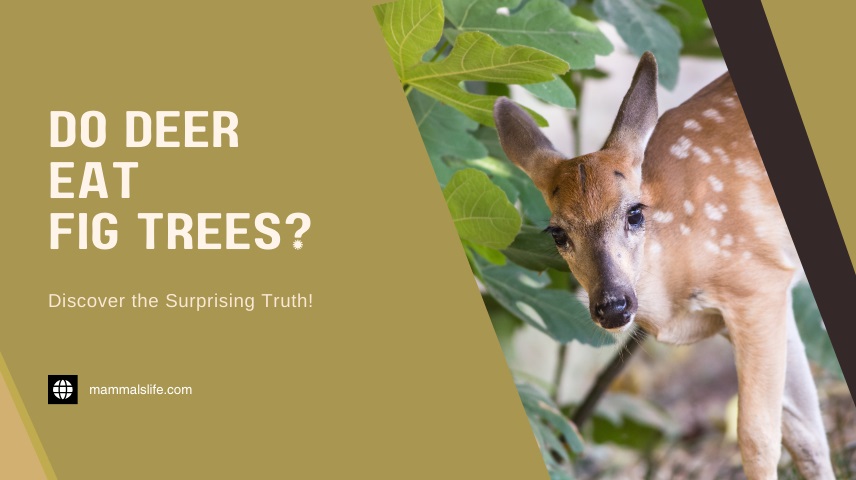Last Updated on February 22, 2025 by Mammals Life
Yes, deer eat fig trees. They enjoy the tender leaves, shoots, and sometimes even the fruit.
Fig trees are a popular choice in many gardens due to their delicious fruit and attractive foliage. Deer, however, can pose a significant threat to these trees. These animals are known for their voracious appetites and can cause extensive damage to fig trees, especially young saplings.
Gardeners often need to take protective measures to keep deer away from their fig trees. Using deer repellents, installing physical barriers, or planting deer-resistant plants nearby can help mitigate the risk. Understanding deer behavior and their dietary preferences is crucial for maintaining a healthy garden. Proper care and preventive strategies can ensure your fig trees thrive despite the presence of deer.
Introduction To Deer And Fig Trees
Deer are common in many regions. Fig trees grow in various climates. Both have unique characteristics that influence their interactions. Understanding these traits helps in managing gardens and orchards.
Overview Of Deer Behavior
Deer are herbivores. They feed on plants, fruits, and leaves. They are known for their browsing habits.
Deer are active during dawn and dusk. They are also cautious and avoid human presence. Their diet changes with the seasons. In winter, they eat twigs and bark.
During spring and summer, they prefer fresh leaves and fruits. This seasonal diet shift impacts gardens and orchards.
Characteristics Of Fig Trees
Fig trees are known for their delicious fruits. They grow well in warm climates. Fig trees have broad leaves and smooth bark. These features make them appealing to deer.
Fig trees produce fruits that are rich in nutrients. The trees have a unique growth pattern. They can grow tall and spread wide. Their fruits are sweet and attract wildlife.
Fig trees require proper care. They need regular watering and pruning. They thrive in well-drained soil. Understanding these needs helps in protecting them from deer.
Deer’s Dietary Preferences
Deer have diverse dietary preferences. They eat various plants and fruits. Understanding these preferences helps in managing gardens and farms.
Common Food Sources
Deer prefer tender leaves and shoots. They often eat grass, shrubs, and herbs. Common food sources include:
- Grasses: Deer eat many types of grass.
- Shrubs: They love tender shrub leaves.
- Fruits: Apples, berries, and grapes are favorites.
- Nuts: Acorns and chestnuts attract deer.
Seasonal Diet Changes
Deer change their diet based on seasons. Seasonal changes affect food availability. This influences their eating habits.
| Season | Food Sources |
|---|---|
| Spring | New shoots, tender leaves, and wildflowers |
| Summer | Fruits, berries, and lush grasses |
| Autumn | Nuts, acorns, and fallen fruits |
| Winter | Bark, twigs, and evergreen plants |
During spring, deer eat new shoots. In summer, they enjoy fruits and berries. In autumn, they prefer nuts and acorns. Winter forces them to eat bark and twigs.
Fig Trees In Deer Habitats
Fig trees are often found in areas inhabited by deer. These trees provide a unique food source for the deer population. Understanding the relationship between deer and fig trees can help in managing both species effectively.
Geographical Distribution
Fig trees grow in various parts of the world. They thrive in regions with warm climates. Common locations include parts of Asia, Africa, and the Americas. These regions also host a significant deer population.
Below is a table showing some regions where fig trees and deer coexist:
| Region | Presence of Fig Trees | Presence of Deer |
|---|---|---|
| Asia | High | High |
| Africa | Medium | Medium |
| Americas | High | High |
Fig Trees In Forest Ecosystems
In forest ecosystems, fig trees play a vital role. They provide food for various wildlife, including deer. The fruit of fig trees is a nutrient-rich source for these animals.
Deer often eat the leaves, stems, and fruits of fig trees. This foraging can impact the health of the fig trees. It can also affect the overall forest ecosystem balance.
- Leaf Consumption: Deer eat fig tree leaves, which are rich in nutrients.
- Stem Damage: Deer may chew on fig tree stems, causing harm.
- Fruit Foraging: Deer consume fig fruits, impacting seed dispersal.
Managing deer populations is crucial for the health of fig trees. Proper measures can ensure both species thrive in their shared habitats.
Do Deer Eat Fig Trees?
Do Deer Eat Fig Trees? This question intrigues many gardeners and wildlife enthusiasts. Fig trees produce sweet fruit and lush leaves. These features attract various animals, including deer. Understanding deer behavior helps protect fig trees from damage.
Incidents Of Deer Eating Figs
People frequently observe deer munching on fig trees. There are numerous reports of deer eating fig fruits and leaves. In rural areas, deer can easily access gardens and orchards. Homeowners often find their fig trees partially eaten. Deer tend to visit fig trees during dawn or dusk. These times are when deer are most active. Below is a table summarizing common incidents:
| Location | Deer Activity |
|---|---|
| Rural Gardens | High |
| Suburban Areas | Moderate |
| Urban Areas | Low |
Scientific Studies And Evidence
Scientific studies confirm that deer eat fig trees. Researchers observe deer behavior in various habitats. Studies show deer prefer tender leaves and ripe fruits. Deer have a keen sense of smell. This sense helps them locate fig trees easily. Research also indicates deer eat figs for nutritional benefits. Figs provide essential vitamins and minerals. Here are some key findings:
- Deer are attracted to the sweet scent of figs.
- Figs offer high energy content for deer.
- Deer eat fig leaves for their moisture content.
Protecting fig trees from deer requires effective strategies. Gardeners often use fencing or repellents. These methods help keep deer away from valuable fig trees.
Protecting Fig Trees From Deer
Deer often eat fig trees, causing damage to your garden. Protecting fig trees from deer is essential for their survival. There are several effective ways to keep deer away from your precious fig trees.
Preventive Measures
Taking preventive measures can help safeguard your fig trees. Here are some tips:
- Fencing: Install a tall, sturdy fence around your garden.
- Netting: Use netting to cover your fig trees.
- Companion Planting: Plant deer-resistant plants nearby.
These measures create a physical barrier, making it harder for deer to reach your trees.
Effective Deer Deterrents
Various deer deterrents can keep deer away from fig trees. Some effective methods include:
- Motion-Activated Sprinklers: These scare deer away with sudden bursts of water.
- Deer Repellent Sprays: Use sprays with strong scents to deter deer.
- Noise Makers: Hang wind chimes or use other noise-making devices.
These deterrents create an environment that deer find uncomfortable.
| Deterrent | Effectiveness |
|---|---|
| Motion-Activated Sprinklers | High |
| Deer Repellent Sprays | Medium |
| Noise Makers | Medium |
Combining multiple deterrents can offer the best protection for your fig trees.
Frequently Asked Questions
Do Deer Eat Fig Tree Leaves?
Yes, deer often eat fig tree leaves, especially the tender young ones.
How To Protect Fig Trees From Deer?
Use deer repellents, install fencing, or plant deer-resistant plants around fig trees.
Are Fig Trees Deer-resistant?
No, fig trees are not deer-resistant and can be damaged by deer.
Can Deer Damage Fig Trees?
Yes, deer can damage fig trees by eating leaves, branches, and even fruits.
Conclusion
Deer can indeed pose a threat to fig trees. Protecting your fig trees is crucial for their survival. Simple measures like fencing or repellents can help. Always monitor your garden to ensure the health of your plants. By taking these steps, you can enjoy a thriving fig tree free from deer damage.








